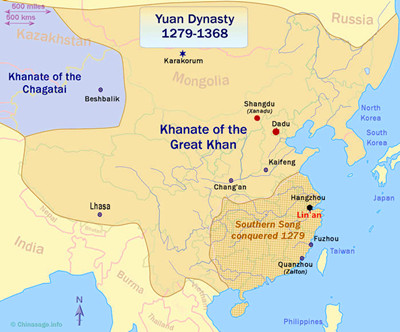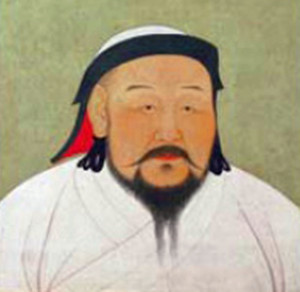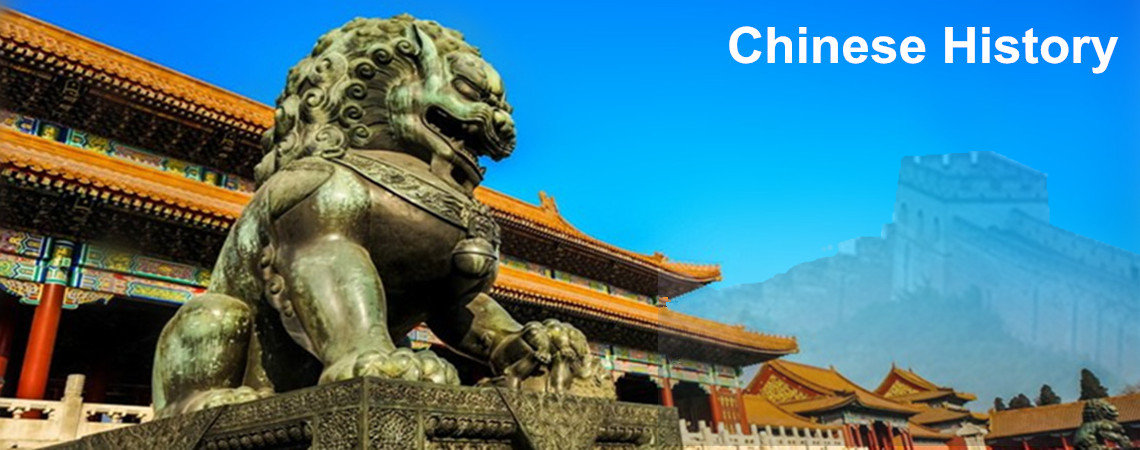- Home
- Travel In China > History of China >
Yuan Dynasty (1279-1368)

Yuan Dynasty (1279–1368) was China's first foreign-led dynasty, in between the Chinese Song and Ming dynasties. It was established by Kublai Khan, leader of the vast Mongol Empire, and fell into internal rebellion after it lost touch with its Mongol roots.
Facts of the Yuan Dynasty
Time: 1279-1368
Location of Capital: Dadu ( Beijing )
Replaced by:
Ming Dynasty
Since the late period of the 12th century, an ethnic minority group called Mongolian had grown up in the northern areas of China. Genghis Khan and his sons set the foundation for the Yuan Dynasty by defeating the Western Xia and conquering Central Asia, Mongolia, and the Hexi Corridor. Trade on the Silk Road trade routes through the Hexi Corridor enriched the Mongol rulers and gave them power. Their control of this land passage allowed their troops to quickly move east or west as conflicts arose.
Genghis Khan (Ruled 1206–1227)
In 1204, one of the leaders of the Mongolian tribes, Tiemuzhen, unified all the internal tribes. Two years later, Tiemuzhen was honored as Genghis Khan (meaning - the ruler of the world) and soon established the Mongolian Empire. Successively, it captured Xixia and the Jin Dynasty (1115 - 1234), after which the combative Mongolian army sent its military forces into Central Asia and Europe.
Ogedei Khan (Ruled 1229–1241)
Genghis Khan died in 1227 and had named his son, Ogedei, to be the next emperor. Ogedei was said to rulethe whole Mongol empire from 1229 to 1241, but he concentrated his efforts in the eastern part of it. In 1232, he invaded the Jin empire in alliance with the Song empire. Jin was defeated in 1234. From 1235, Ogedei started a campaign with the Song Dynasty.
Kublai Khan (Ruled 1260–1294)
Kublai was a grandson of Genghis Khan. He had a comparatively long rule and reformed the empire to increase his power and make the empire prosper.
In 1253, he captured the Dali Kingdom in Yunnan Province.
In 1260, Kublai took the throne after his elder brother, Mongke, died.When he heard that his elder brother, who was the Great Khan Mongke, had died, he and another brother went to war. Both of them wanted to be the Khan.
Early Period of the Yuan Dynasty
Emperor Shizu (1279-1294)

In 1266, Kublai made Dadu (modern-day Beijing) his capital, and this further alienated him from his Mongol kinsmen who claimed he didn't follow Mongol ways and wasn't loyal to the Mongols.
In 1271, Kublai Khan founded the Yuan Dynasty, which coexisted with the Southern Song Dynasty.
In 1279 , Song Dynasty was ended by Yuan Empire.
Kublai Khan united China and was called
Emperor Shizu
In 1280, Emperor Shizu campaigned against Japan but he was failed.
As the first emperor of the Yuan Dynasty, Kublai Khan initially adopted the political system of Han people. In economy, Kublai Khan focused much attention on the development of agriculture and water conservancy construction. In the early period of Kublai Khan's reign, the agricultural production gradually recovered and the cultivation areas were greatly increased.The control and exploitation towards the border areas were greatly promoted, which enhanced the cultural and economical ties between people in ethnic minorities in border areas and inland regions. At that time, there were a total of eleven 'Xingsheng's making up the whole nation, including the newly unified Yunnan, Tibet, Taiwan and Penghu areas.
Emperor Wuzong (1307–1311)
After Kublai Khan died in 1294, Emperor Chengzong ascended the throne. Because he was a conservative and weak-minded emperor, the society of the Yuan Dynasty failed to progress in his reign.
In 1307, he was succeeded by Emperor Wuzong who was more incompetent in dealing with the state affairs. Emperor Wuzong reign lasted only a few years from 1307 to 1311 but the empire had a severe debt and inflation problem, and discontent grew. During his reign, the value of the paper currency was devalued by about 80 percent. This procedure enriched the court and the Mongols relative to the rest of the population but impoverished the population in general, especially the rich Chinese merchants and officials.
Since the Mongol rulers could print as much paper currency as they wanted, they printed too much and the value of the money kept dropping. The costly wars and great defeats were financed largely with paper money and, to reinforce their monetary control, they outlawed the use of gold and silver currency.
Later Period of the Yuan Dynasty
None of the late emperors of Yuan were as competent and as ambitious as Kublai Khan, hence the Yuan Dynasty began to decline after Emperor Wuzong. Starting from Emperor Taiding, the power struggle within the ruling class became more and more intense, let alone the severe ethnic contradiction caused by the 'Four Class System'. Since then, the Yuan Dynasty could not stop its step to decline.
Emperor Mingzong (Ruled 1329–1332)
From the 1330s onward, natural disasters, such as epidemics, droughts, and floods, brought suffering and death to the peasants. The Little Ice Age began, and similar famines and natural disasters caused political instability around the world at the same time.
In 1331, the bubonic plague pandemic, known as the "Black Death" in Europe, began to sweep the empire. The epidemic ravaged the empire. Millions of people died in Hebei Province alone.
Emperor Huizong (Ruled 1333–1367)
In 1344, the Yellow River shifted course. This caused a massive flood that impoverished an important and populous region at the center of the empire. The river flooded on two other occasions during the last couple of decades.
There were also massive famines. There was a time of drought that lasted from 1340 to 1380. In 1351, a rebellion started called the Red Turban Rebellion. The Red Turbans said that the bad rule of the Yuan Dynasty caused the natural disasters because they lost the Mandate of Heaven. The court defeated the rebellion but more started soon after.
Between 1356 and 1367, an important leader of the Red Turban Rebellion, Zhu Yuanzhang, defeated all the other powerful rival armies. In 1368, he attacked the Yuan empire capital of Dadu (Beijing) and gained control of it. The Yuan court fled northwards.
Mongolia became the final home of the Yuan Dynasty clans. Mongolians kept trying to recapture the empire but they failed. They eventually allied with the Manchus, and Mongolians became officials in the
Qing Dynasty.
Zhu Yuanzhang destroyed the Yuan palaces. He established a new dynasty called the
Ming Dynasty.

 Yuan Dynasty (1279–1368) was China's first foreign-led dynasty, in between the Chinese Song and Ming dynasties. It was established by Kublai Khan, leader of the vast Mongol Empire, and fell into internal rebellion after it lost touch with its Mongol roots.
Yuan Dynasty (1279–1368) was China's first foreign-led dynasty, in between the Chinese Song and Ming dynasties. It was established by Kublai Khan, leader of the vast Mongol Empire, and fell into internal rebellion after it lost touch with its Mongol roots. In 1266, Kublai made Dadu (modern-day Beijing) his capital, and this further alienated him from his Mongol kinsmen who claimed he didn't follow Mongol ways and wasn't loyal to the Mongols.
In 1266, Kublai made Dadu (modern-day Beijing) his capital, and this further alienated him from his Mongol kinsmen who claimed he didn't follow Mongol ways and wasn't loyal to the Mongols.






 Ask Questions ?
Ask Questions ?